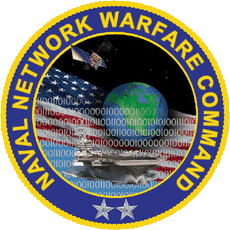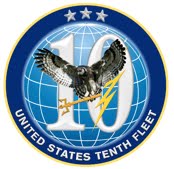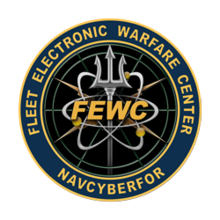Electronic warfare (EW) is any action involving the use of the electromagnetic spectrum or directed energy to control the spectrum, attack an enemy, or impede enemy assaults. The purpose of electronic warfare is to deny the opponent the advantage of, and ensure friendly unimpeded access to, the EM spectrum. EW can be applied from air, sea, land, and/or space by manned and unmanned systems, and can target humans, communication, radar, or other assets.

United States Strategic Command (USSTRATCOM) is one of the eleven unified combatant commands in the United States Department of Defense. Headquartered at Offutt Air Force Base, Nebraska, USSTRATCOM is responsible for strategic deterrence, global strike, and operating the Defense Department's Global Information Grid. It also provides a host of capabilities to support the other combatant commands, including integrated missile defense; and global command, control, communications, computers, intelligence, surveillance, and reconnaissance (C4ISR). This command exists to give national leadership a unified resource for greater understanding of specific threats around the world and the means to respond to those threats rapidly.

The Rapid Equipping Force (REF) is a United States Army organization headquartered in Fort Belvoir, Virginia. The organization is charged with quickly providing Army units deployed globally with innovative government off-the-shelf and commercially available solutions that address urgent requirements within 180 days or less. The REF is able to do this through unique authorities and by maintaining a presence near the point of need. REF personnel are positioned in Iraq, Afghanistan, and Kuwait and mobile laboratories are available for quick solutions. Additionally, the REF empowers the Army at a grassroots level, enabling individual Soldiers to communicate needs directly through simple request forms.
The Joint Capabilities Integration and Development System (JCIDS), is the formal United States Department of Defense (DoD) process which defines acquisition requirements and evaluation criteria for future defense programs. JCIDS was created to replace the previous service-specific requirements generation system that allowed redundancies in capabilities and failed to meet the combined needs of all US military services. In order to correct these problems, JCIDS is intended to guide the development of requirements for future acquisition systems to reflect the needs of all four services by focusing the requirements generation process on needed capabilities as requested or defined by one of the US combatant commanders. In an ideal implementation of the JCIDS process, regional and functional combatant commanders give early and continuous feedback into the acquisition and sustainment processes to ensure their current and evolving requirements are known and met.
The Force Element Groups (FEGs) of the Australian Defence Force are the operational capabilities.

The Asymmetric Warfare Group is a United States Army unit created during the War on Terrorism to mitigate various threats with regard to asymmetric warfare. The unit is headquartered at Fort Meade, Maryland and has a training facility at Fort A.P. Hill, Virginia. The unit provides the linkage between Training and Doctrine Command (TRADOC) and the operational Army, and reports directly to the commanding general of TRADOC. It is composed of senior active duty Soldiers, D.A. civilians, and contractors who are seasoned war fighters and functional area experts that are prepared to deploy globally.

The Navy Expeditionary Combat Command (NECC) serves as the single functional command to centrally manage current and future readiness, resources, manning, training and equipping of the United States Navy's 21,000 expeditionary forces who are currently serving in every theater of operation. The NECC was established in January 2006. NECC is a subordinate command of the Navy's Fleet Forces Command.
The structure of the United States Navy consists of four main bodies: the Office of the Secretary of the Navy, the Office of the Chief of Naval Operations, the operating forces, and the Shore Establishment.

Naval Network Warfare Command (NETWARCOM) is the United States Navy's information operations, intelligence, networks and space unit. Naval Network Warfare Command's mission is to execute, under Commander TENTH Fleet Operational Control, tactical-level command and control of Navy Networks and to leverage Joint Space Capabilities for Navy and Joint Operations.
Capability management is a high-level integrative management function, with particular application in the context of defense.
DOTMLPF is an acronym used by the United States Department of Defense. DOTMLPF is defined in The Joint Capabilities Integration Development System, or JCIDS Process. The JCIDS process provides a solution space that considers solutions involving a simulation of doctrine, organization, training, materiel, leadership and education, personnel, and facilities (DOTMLPF) required to accomplish a mission. Because combatant commanders define requirements in consultation with the Office of the Secretary of Defense (OSD), they are able to consider gaps in the context of strategic direction for the total US military force and influence the direction of requirements earlier in the acquisition process, in particular, materiel.
United States Army Computer Network Operations-Electronic Warfare Proponents (USACEWP) is the United States Army agency responsible for ensuring cyber electronic warfare capabilities are fully integrated into full-spectrum operations for the land component commander. Cyber warfare is an evolving land component doctrinal precept composed of computer network operations and Electronic Warfare. The Director, USACEWP, reports to the Commanding General, United States Army Combined Arms Center, Fort Leavenworth, Kansas.

The U.S. Tenth Fleet is a functional formation and a numbered fleet in the United States Navy. It was first created as an anti-submarine warfare coordinating organization during the Battle of the Atlantic in the Second World War. It was reactivated as a force provider for Fleet Cyber Command on January 29, 2010. U.S. Tenth Fleet serves as the numbered fleet for U.S. Fleet Cyber Command and exercises operational control of assigned naval forces to coordinate with other naval, coalition and Joint Task Forces to execute the full spectrum of cyber, electronic warfare, information operations, and signal intelligence capabilities and missions across the cyber, electromagnetic, and space domains.

The Air Warfare Centre (AWC) is a Royal Air Force research and testing organisation based at RAF Waddington in Lincolnshire. It has a training branch nearby as a lodger unit of RAF Cranwell and other branches elsewhere, including at RAF High Wycombe, RAF Brize Norton, MOD Boscombe Down, and RAF Odiham.

Special operations capable (SOC) is a collaborated concept formulated of the United States Marine Corps and Navy, under the direction of the Department of the Navy, concerning the expeditionary roles whom the Fleet Marine Force and its subordinate Marine task forces are assigned. This designation is restricted only to the Marine Expeditionary Units—as per "Marine Expeditionary Unit (Special Operations Capable", or "MEU ", and is unique to the Marine Corps and is NOT associated with the common special operations although considered special operational forces capable these units do not fall under the United States Special Operations Command —or by any other military branches of the United States—and its primarily and strictly limited to the United States Marine Corps and Navy.
Fleet Command is responsible for the command, operations, readiness, training and force generation of all ships, submarines, aircraft squadrons, diving teams, and shore establishments of the Royal Australian Navy. Fleet Command is headquartered at HMAS Kuttabul in Sydney, and is led by the Commander Australian Fleet (COMAUSFLT), also referred to as Fleet Commander Australia (FCAUST), which is a rear admiral (two-star) appointment.
The Navy Warfare Development Command (NWDC) is a command of the United States Navy for the generation and development of innovations in concepts and doctrine for enhanced operational level maritime capability and integration in joint and coalition activities. The NWDC is currently located at Naval Station Norfolk, VA.
A battle lab or battle laboratory is a capability enabled by a set of means to analyze or assess impacts that could be induced by changes in a military realm. The changes can be of any kind: equipment, technologies, organization, doctrine or changes in the environment itself.
The Fourth Department (4PLA) of the Chinese People's Liberation Army (PLA) Joint Staff Department (JSD) is also known as the Electronic Countermeasures and Radar Department. It is charged with the PLA's offensive electronic warfare (EW) and information warfare (IW) missions, to include offensive cyber operations. Based on PLA doctrine and 4PLA's mission, this department will almost certainly play a major role in future conflicts, including conflicts with the U.S. While information on 4PLA can be sparse, this paper will attempt to pull together many sources to provide an overview of 4PLA, to include its history, the role of an important 4PLA leader and the doctrine that he produced, 4PLA's responsibilities and mission, its organizational structure, 4PLA's relationship with other organizations in China, its locations and size, and how 4PLA and its related doctrine could be used in battle.
The Cyber Center of Excellence (CCOE) conducts annual prototyping experiments within an operational context called Cyber Quest. This prototyping experiment assesses emerging technologies against documented Cyberspace, Electronic Warfare (EW) and Signal operational capability requirements. It informs current capability development and doctrine writing efforts, and understands the impact of DOTMLPF. The Cyber Battle Laboratory (CBL) is the lead element for the Cyber CCOE in delivering Cyber Quest.









